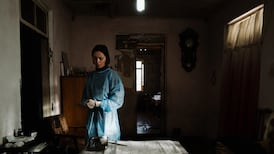RL Stine may be one of the most successful authors of our era, but, being a modest and amusing fellow, he'd much rather talk about other writers.
"I've actually done entire interviews about the author Sebastian Barry, " says the Goosebumps creator. "He's a really good friend of ours in Wicklow. I think he's the best prose stylist on Earth. I really do. We should just talk about him."
Published in 1764, The Castle of Otranto by Horace Walpole is widely regarded as the first gothic novel. Walpole's use of ancient curses, a reluctant bride, tower imprisonment, and things that go bump in the night has influenced centuries of subsequent writing, from Mary Shelley to Bram Stoker, Shirley Jackson to Toni Morrison.
No one, however, thought to write such spooks and frights into a children’s book; no one, that is, until RL Stine.
“I was always surprised there weren’t more protests,” says Stine. “I expected there would be a lot more trouble. Especially from conservative areas. The thing is that we had so much support from librarians and teachers. And that really helped a lot. Now, we’ve been around so long, people just don’t even think about it.”
Stine is best known as the author of Goosebumps, the children’s horror-book franchise that, since it debuted in the early 1990s, has spawned TV series, video games, plastic masks, its own land in a Disney theme park, and a West End theatre show.
A 2015 hit movie starring Jack Black as a (very) fictionalised Stine and its sequel, Goosebumps 2: Haunted Halloween, have grossed more than $250 million at the box office.
“How lucky am I?” cries Stine. It’s one of his favourite phrases, I soon learn. “When it comes to movies, you never know what you’re gonna get, right? Of course, I always have very little input. And as you know, I’ve been so lucky with movies and TV series. The two Goosebumps movies were terrific. They turned out really good. And these new Fear Street movies are really good. I think people are going to love them.”
The Fear Street Trilogy, comprising Fear Street Part One: 1994, Fear Street Part Two: 1978, and Fear Street Part Three: 1666, is a major, fun-filled, temporal-jumping sequence of movies from Netflix. Drawing on the RL Stine book series of the same name – a sequence that Publishers Weekly has listed as the bestselling young-adult book series of all time – the Fear Street films concern various attractive teens from two American small towns: picture-perfect, salubrious Sunnyvale and the benighted, crime-ridden Shadyville.
Though aimed squarely at Netflix’s growing adolescent market, grown-up 1990s kids will love the nostalgic soundtrack and dial-up tech. Still older viewers will lap up the ’70s instalment with its nods to the great campsite horrors of that era.
Intergenerational fan base
By now, Stine, who has sold more than 400 million books, is accustomed to an intergenerational fan base.
“That was very weird at first,” recalls Stine. “It took me a long time to get used to that. I’d show up at book signings and there’d be 10-year-olds and 12-year-olds. And then there were 35-year-olds. What are you doing here? But it’s great. I get to scare so many generations. It’s a nice thing.”
Being married to your editor is a really bad idea. We've been married many years and I've never won a bet
This latest screen incarnation of Stine's work has already picked up rave notices from critics with a soft spot for slasher nostalgia. Director and co-writer Leigh Janiak (best known for the Scream TV series) augments the clubhouse adventure of the original Fear Street books with the (very '90s) knowingness of the Scream movies and some R-rated grinding. Of all varieties.
“I’ve never written anything R-rated in my life,” laughs Stine. “I haven’t done anything R-rated in my life. They are much more adult. I’d say they’re a lot scarier than the Goosebumps movies. And they’re scarier than the Fear Street books. I think a lot of old-time readers are going to be surprised by how many screams there are, and how many people get chopped up. But I think now that a lot of the readers are older, they’ll enjoy it a lot.”
At a time when literature for kids and teenagers is increasingly gritty, RL Stine's work retains a sense of innocence and wonder. The "Stephen King of children's literature", as he is often called, knows how to marry a jump-scare and a punchline. His stories frequently have the feel of campside tall tales or urban legends; they also share DNA with the fun, high-concept creature features and B-movies of the 1950s, in which the plot is trumpeted in the title. Unsurprisingly, the author of Jekyll and Heidi, The Knight in Screaming Armor, Secret Agent Grandma, and Who's Been Sleeping in My Grave? typically comes up with the title first.
"I just keep going," he says. "I'm working on four different book projects. I just signed on to do six more Goosebumps books. Goosebumps is in its 30th year. It's near magic. It's hard to believe. And so far whenever I need an idea I have an idea. Sometimes I'll be walking my dog in the park and a title will pop into my head. Say Cheese and Die! [the title of the fourth book in the original Goosebumps series] – where'd that come from? I actually don't even try to think of ideas anymore. I've done every story a human can do, right? I only try to think of good titles. And when I have the title, it'll lead me to a story. One of the most recent Fear Street books had this title I really liked called: You May Now Kill the Bride. And right away, there's a wedding on a cliffside."
Becoming a writer
RL Stine’s journey into writing sounds like, well, something from an RL Stine story. Born in 1943 in Columbus, Ohio, Stine, the oldest of three siblings born to a homemaker mother and shipping clerk father, began writing joke books after finding a mysterious typewriter in the family attic.
"It was so long ago maybe it is one of my stories," says Stine. "I can't remember. I was nine. I was a weird kid. I was a weird kid who stayed in my room. I was very shy and very fearful. And I think that's one reason I liked staying by myself and writing and creating all these worlds when I was nine and 10 years old. I don't know where it came from in my family. I don't know anything about my family. We came from all over. My grandparents came over from Russia. They were mostly dead by the time I was born. My parents didn't understand me. They didn't get it at all. They were always saying: stop typing and go outside and play. Which is the worst advice I ever got."
As a writer, Stine started out in the funny business, writing joke books under the name Jovial Bob Stine and creating the humour magazine Bananas. He invented celebrity interviews with The Beatles and Diana Ross at a now-defunct New York magazine and spent a year working at a soft drinks trade magazine.
“I had a cousin who was determined that I would be a doctor,” says the author. “Something I could fall back on, right? Being a surgeon. He never gave up. I think I was, like, 25 years old and I was already writing when he said: It’s not too late to go to medical school. I can still get you in. Who wants to be a writer?”
People always say, oh, kids don't read, it's so hard to get kids to read. It's not true at all
No one was more surprised than the author when he found himself on the Forbes list of the 40 best-paid entertainers of 1996–97, or when in 2003 the Guinness Book of World Records named Stine as the bestselling children’s book series author of all time.
Despite winning any number of kid’s choice and people’s choice awards, he’s far prouder of his presence in libraries and schools.
“The thing I’m most proud of is all the millions of kids who learn to read from my books. All the parents who come up to me and say, my kid never read a book in his life. And I caught him reading in the middle of the night under the covers with a flashlight. That’s thrilling to me. I never get tired of hearing that.”
Key to success
The key to his success, he says, is simple. Quite unlike the family dysfunction that underpins most Spielbergian adventures, Stine kids remain entirely independent of adult woes.
“I have a very strict rule for writing for kids,” he says. “And the rule is, they have to know that it couldn’t really happen. They have to know that it’s a fantasy. And if you do that, and they know it couldn’t happen, then you can go pretty far with the scare. But for teenage stories, it’s sort of the exact opposite. Everything has to seem real. They won’t accept anything else. They want fantasy stories with reality in the details. And that’s harder, and it’s harder to know how far to go. And a lot of times my editors are saying, make it scarier.”
Stine's wife is Jane Waldhorn, an editor and writer, with whom he co-founded Parachute Press in 1983. For many years, she edited his books.
“Well, that was basically a nightmare,” he jokes. “Being married to your editor is a really bad idea. We’ve been married many years and I’ve never won a bet. Because she’s always right. So I was lucky. The only thing we would ever fight about was plots. So it worked out well.”
Stine has been about long enough to watch his own little furrow in publishing become a fertile seam. It’s a good thing too, he says.
“Children’s publishing when I started, like in 1970, was a tiny business. You know, it was always a few women at the back of the publishing house, putting out a children’s book. And now it’s billions of dollars. And people always say, oh, kids don’t read, it’s so hard to get kids to read. It’s not true at all. Somebody is reading all these books.”
Fear Street Part One: 1994 premiered on Netflix on July 2nd; Fear Street Part Two: 1978 will premiere on July 9th; Fear Street Part Three: 1666 will premiere on July 16th




















